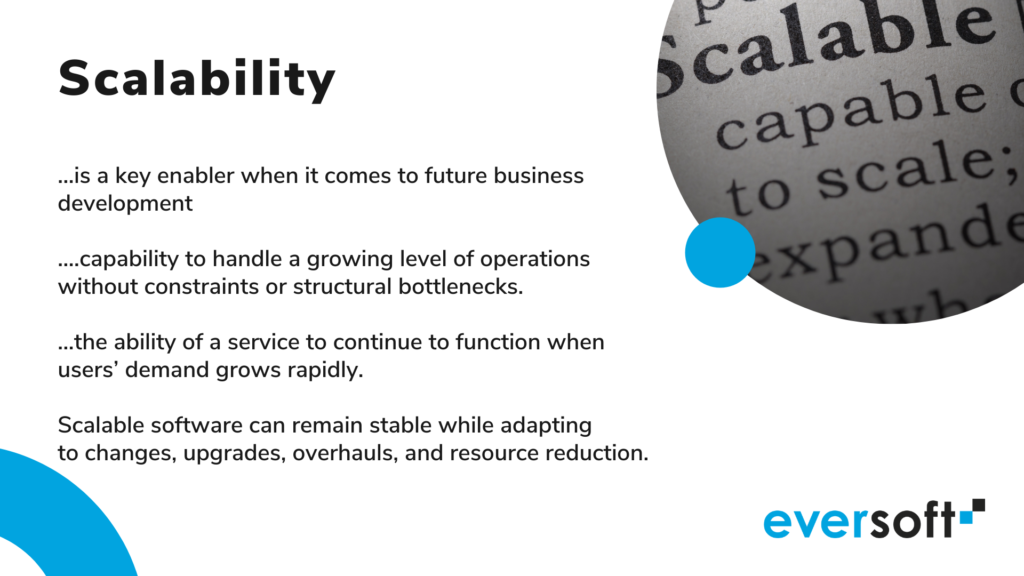Do insurance startups really plan ahead? How to prepare for software scale-up and maintenance?
Every startup is created with success in mind – they want to reach a big group of customers for their product or service. The same rule applies to insurance startups that aim to create a new software-based solution.
Therefore when starting work on a new project, it is important to be prepared right from the beginning for its scale-up and future maintenance. Eventually, the developed solution should support the business not only for the coming months but years to come.
The rest of the article is available below free e-book form

It’s an obvious fact that every business owner is under pressure to grow their business quickly, which leads to higher transaction volumes and increased operational activity. Software solutions have to keep pace with this rapid growth, which is why software scalability is a key enabler when it comes to future business development.
We define system scalability as the capability to handle a growing level of operations without constraints or structural bottlenecks. In other words, it is the ability of a service to continue to function when users’ demand grows rapidly. Scalable software can remain stable while adapting to changes, upgrades, overhauls, and resource reduction.

We divide the scalability into two categories: physical and intangible.
Physical
When saying “physical” we are thinking of all parameters that a company possesses to handle scaled up operations in a sustainable manner (i.e., data storage, network bandwidth, hardware, etc.). In this case sustainable means the ability to cover not only the current needs but also ensure seamless operation in the future. Physical sustainability, in turn, is aiming at stability and reliability.
Intangible
Intangible is regarded as a capacity to support any non-physical growth. For instance, if the company introduces new products the platform has to be equipped with functions that allow scaling. But why is it so important for our business? Since it is a precondition for any development this can be seen as an inherent ability to be competitive. Here are some examples:
- New products to be hosted on same platform/solution
- Additional brands (for multi-brand organisations)
- Additional business processes
In order to achieve true scalability, businesses must address both physical and intangible factors simultaneously.
Maintenance – the key to success
As many practitioners tend to say, software maintenance is equally important as the development phase. Only if maintenance is performed regularly can it keep the system up and running, ready to deal with frequent changes in the business environment at the same time. Therefore, maintenance works have to be taken into consideration while developing the software, not after its completion.
We define software maintenance as a part of the software development life cycle aiming at modifying and updating the software to fix bugs and improve overall performance. It must be noted that in general software development gets completed within 5 years whereas maintenance is an ongoing process that can be extended by up to 15-20 years.
Bug fixing is an essential part of maintenance that allows the software to run smoothly. Furthermore, capability enhancement for changing the environment focuses on software programs, work patterns, hardware upgrade, compilers and all other aspects that affect system workflow.
While maintaining the software, one must also take care of performance improvement and the removal of outdated or redundant functions that occupy space leading to the lower performance.

How to prepare your software for scaling up and maintenance?
To ensure smooth scaling up and ongoing maintenance, you must consider a few things before the project starts.
By design, there is a need for tools to enforce coding standards to keep high-quality code through the development. Of course, full compliance with rules takes some resources. You need the right tools and the right people reviewing the code. But in return, you can expect much less errors, rework and delays.
Aslo make sure you use predictive module testing to identify errors or bugs on smaller chunks of code early on. Additionally, thanks to tools like SonarQube you will be able to run unit tests during your project.
While developing (especially when using the Agile methodology) there is a need for Continuous Integration (CI); a good CI like Octopus radically speeds up the entire workflow reducing the chances of breaking anything while making code changes.
Furthermore, future roadblocks can be avoided by applying software modularity with clear communication between each module. You cannot forget about creating APIs that can be utilised by external services, which in turn can eventually contribute to the rapid growth of your product.
Takeaway
Many companies face problems when it comes to scaling. Rapid growth, which comes as a surprise, can bring many challenges. Growing and securing your wider business objectives at the same time is not an easy task. Therefore, it’s advised prepare carefully, taking some time during software development to carefully plan its future growth and maintenance. This will lower costs and speed up the maturity of your insurtech company.
Related posts:
- Startup Software Development: How to avoid key mistakes in primary architecture and technology choices
- 9 code quality sins made by startups in their software development process
- Key mistakes in Startup Software Development




